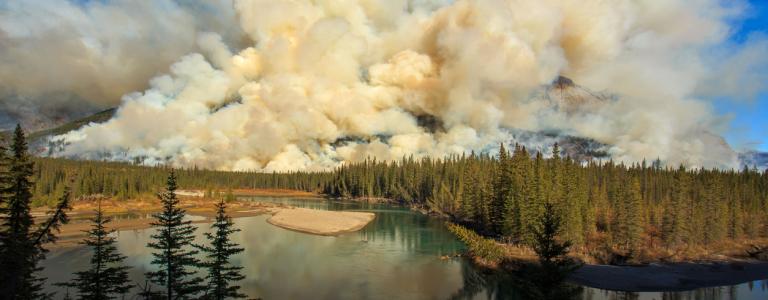A focus on water can lessen climate change’s burn
Canadians need water infrastructure to protect us in the face of mounting risks of flooding, drought, extreme heat, and wildfires.
This article is republished with permission from The Hill Times' website. The original article was published on May 17, 2023.
Here in Alberta, the wildfires that have engulfed my province and displaced close to 30,000 people are devastating—forcing farmers from their ranches, families from their homes, and children from their schools.
The early wildfire season unfortunately serves as a sobering reminder that the intensifying impacts of climate change are affecting local communities, livelihoods, and ecosystems.
How might we fight the fires of climate change – both the real ones burning actively in Alberta and the broader risks facing communities across Canada?
Well, we fight fires with water.
Firefighters on the frontlines know this, but we need all Canadians to understand—with renewed urgency—just how critical water is to our wellbeing and prosperity in the face of climate change.
This week, we learned the range of water challenges facing prairie communities. Among them, perennial underfunding of water infrastructure, including stormwater, wastewater, and potable water assets, has caused their depreciation to outpace investment by $3 billion in just four years.
By water infrastructure, we mean what you might understand as traditional infrastructure—think pipes, dams, and water treatment facilities.
Canadians need water infrastructure to provide clean drinking water, manage stormwater and wastewater, ensure reliable water supplies for key economic sectors, and to protect us in the face of mounting risks of flooding, drought, extreme heat, and wildfires.
But it is growing more challenging for traditional—or “grey”—infrastructure to keep pace with the needs of communities, especially as rising costs and climate change add pressure.
Thankfully, evidence from around the world and here in Canada, shows that nature can help to bridge the gap, in the form of natural infrastructure.
Natural infrastructure is a way to plan and work with nature to meet infrastructure needs. It can be a conserved ecosystem, a restored ecosystem, or even a nature-based engineered feature. Examples range from conserving and restoring wetlands to reduce flood risk and retain soil moisture to installing green roofs on top of public buildings for reduced stormwater volumes.
And natural infrastructure works—proving to be reliable and cost-effective, easing the burden on traditional water infrastructure systems. It also provides extra benefits – for example, wetlands can protect against flooding, while also storing carbon, supporting biodiversity, and even property values.
There are exciting examples peppered across the prairies. A tertiary treatment wetland in La Broquerie, Manitoba uses the power of plants to ensure phosphorus levels meet regulatory requirements before discharging to the Seine River. A bioretention bed in Okotoks, Alberta collects, stores, and cleans stormwater used in a local irrigation system. But these projects are far from the norm; we need a more coordinated approach to scale up natural infrastructure across the country and in the prairies.
And soon.
And while Canada’s federal government is supportive of building more natural infrastructure solutions to complement traditional infrastructure—evident by funding through the Natural Infrastructure Fund and plans to include natural infrastructure in the first ever National Infrastructure Assessment—we need to ensure that key investments and programs reach prairie communities in Alberta, Saskatchewan, and Manitoba; and beyond.
We can build on recent momentum—including the draft National Adaptation Strategy—to ensure the right supports are in place to help prairie communities make their water infrastructure more resilient.
But how?
First, we need to ensure adequate and more accessible funding for those, across all sectors, who want to implement natural infrastructure. Accessibility is key – while “shovel ready” projects are great, more support for the upfront development of projects can increase local uptake, particularly in rural or underserved communities who may lack capacity or expertise.
We also need to make a stronger business case for local projects, to show where natural infrastructure is a cost-effective and impactful option that provides a clear return on investment.
And, to facilitate all of this, we need to enable policies at all levels of government to make it easier for those who want to implement natural infrastructure — smaller municipalities, rural counties, Indigenous communities, agricultural producers, industry, and investors.
Natural infrastructure can be an extra firewall against the worst impacts of climate change. Let’s focus on water to lessen the burn.
Funded by
You might also be interested in
Funding for Canadian Prairies’ water infrastructure urgently needed, but nature offers innovative solutions—new report
The Canadian Prairie provinces’ water infrastructure is aging and depreciating at an alarming rate. However, natural infrastructure can offer a practical and cost-effective solution when scaled up and adopted across all levels of government.
The State of Play of Natural Infrastructure on the Canadian Prairies
We sat down with key experts across the region and reviewed the latest literature to determine how we take natural infrastructure from novel to normal on Canada's Prairies.
Summary of the 2022 IISD Forum on Natural Infrastructure Performance and Metrics
Participants discussed key challenges, opportunities, and technical considerations to building a better business case for natural infrastructure across Canada's Prairies.
For Nature-Based Solutions to Be Effective, We Need to Work with Indigenous Peoples and Local Communities
Nature-based solutions have been praised as a promising approach to tackling the twin crises of climate change and biodiversity loss. But some Indigenous Peoples and local communities are questioning the legitimacy of the concept and what it symbolizes. It is time to listen to what they have to say.

